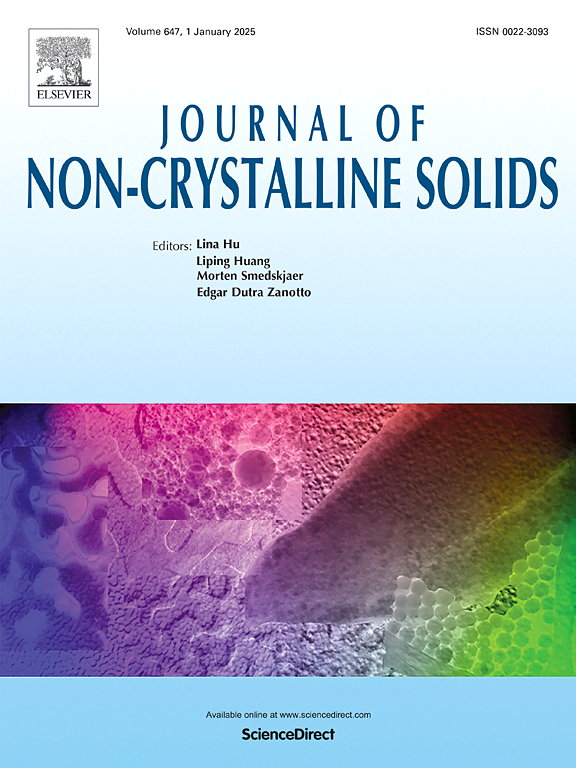Magnesium and calcium mixed effect on thermal conductivity in a borosilicate glass
IF 3.2
3区 材料科学
Q1 MATERIALS SCIENCE, CERAMICS
引用次数: 0
Abstract
To investigate the mixed effect of magnesium and calcium on thermal conductivity, a series of borosilicate glasses with varying molar ratios R (R = [MgO]/([MgO]+[CaO])), specifically 65.0SiO2·5.0B2O3·17.4Na2O·0.5K2O·(12.1-x)CaO·xMgO, were synthesized. As MgO content increased, thermal conductivity exhibited a near-linear rise for R values from 0.0 to 0.6, followed by a negative deviation up to R = 1.0. Utilizing the phonon gas model, key factors influencing thermal conductivity—volumetric heat capacity (C), phonon mean free path (l), and Debye sound velocity—were analyzed. Given the minimal variations in C and l, Debye sound velocity emerged as the predominant factor governing thermal conductivity in these glasses. Furthermore, by examining the dual roles of Mg cations as either network modifiers or formers, alongside the evolution of Si-O tetrahedra-related clusters through Raman and NMR spectra, we elucidated the atomic-scale structural origins driving the linear and nonlinear dependencies of thermal conductivity on R.
镁钙混合对硼硅酸盐玻璃导热性能的影响
为了研究镁钙混合对导热性能的影响,合成了一系列不同摩尔比R (R = [MgO]/([MgO]+[CaO])的硼硅酸盐玻璃,即65.0SiO2·5.0B2O3·17.4Na2O·0.5K2O·(12.1-x)CaO·xMgO。随着MgO含量的增加,导热系数R值在0.0 ~ 0.6范围内呈近似线性上升,随后出现负偏差,直至R = 1.0。利用声子气体模型,分析了影响热导率的关键因素——体积热容(C)、声子平均自由程(l)和德拜声速。考虑到C和l的最小变化,德拜声速成为控制这些玻璃导热性的主要因素。此外,通过研究镁离子作为网络改进剂或形成剂的双重作用,以及通过拉曼和核磁共振光谱分析Si-O四面体相关簇的演变,我们阐明了驱动导热系数对R的线性和非线性依赖的原子尺度结构起源。
本文章由计算机程序翻译,如有差异,请以英文原文为准。
求助全文
约1分钟内获得全文
求助全文
来源期刊

Journal of Non-crystalline Solids
工程技术-材料科学:硅酸盐
CiteScore
6.50
自引率
11.40%
发文量
576
审稿时长
35 days
期刊介绍:
The Journal of Non-Crystalline Solids publishes review articles, research papers, and Letters to the Editor on amorphous and glassy materials, including inorganic, organic, polymeric, hybrid and metallic systems. Papers on partially glassy materials, such as glass-ceramics and glass-matrix composites, and papers involving the liquid state are also included in so far as the properties of the liquid are relevant for the formation of the solid.
In all cases the papers must demonstrate both novelty and importance to the field, by way of significant advances in understanding or application of non-crystalline solids; in the case of Letters, a compelling case must also be made for expedited handling.
 求助内容:
求助内容: 应助结果提醒方式:
应助结果提醒方式:


